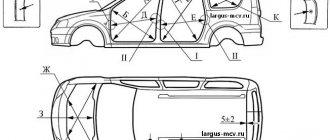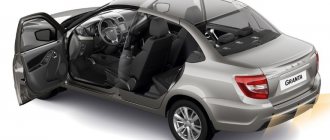In the vastness of the countries of the former USSR, it is perhaps difficult to find a person who has never heard of the Niva car. The first Soviet SUV gained the sympathy and respect of a huge number of citizens of the USSR, but as time passed, the quality of materials available for production grew, not to mention technical progress.
"Niva" has gone through several modifications and restylings. One of such “brainchild” of the domestic crossover is the VAZ 21213 “Taiga”. In this article we will look at the classic Niva and the Taiga model, highlighting their advantages and disadvantages. Let's find out what is the difference between car models.
Is Lada Taiga so good for Germans?
Lately, we have increasingly begun to notice a strange feature about the Germans. Reviews and even test drives of Russian cars appear in local publications every now and then. Basically, these are either nostalgic notes about old trucks and buses from the country of the Soviets or discussions on a modern topic, like, is the Lada Vesta, UAZ Patriot or SUV from AvtoVAZ, the 4x4 model, so good?
See also: The Germans are shocked: Lada Niva vs. Bentley Bentayga
Today we would like to give a new example of what German journalists think about an old SUV from Russia. The Lada Niva, which is sold in Germany under the name Taiga, was brought in for a brief review of the car. This is what the Germans once again found out about Russian classics.
Price of 5-door Niva Urban
Stock equipment will cost 527,000 rubles. It is positioned as Luxe, and so far the only one. For this price you will get the interior equipped with anchors for child seats and a whole set of safety systems (ABS and auxiliary braking complex) inherent in a typical city car. The same package of options provides a main socket (12V) and an additional one: which is located in the trunk niche, electric windows in the front doors, air conditioning, power steering and standard body vibration insulation. The windows are lightly tinted from the factory, and the mirrors are now heated as standard. They are still controlled by the same electric drive.
Lada Taiga
The SUV is over 40 years old. During this time, little has changed. The engine is still of a modest size, but it makes noise when running, like a V8 from a truck, the gearbox does not always engage the gears the first time, the plastic parts are not made in the most diligent way...
There is not much to expect from the old man, but I would like the car to be more modern. However, then she will lose her unique charm. In general, the difficulty of combining incompatible things.
It will go everywhere! Anyone who buys a Lada Taiga 1.7 does not expect the perfect car, but understands that for that kind of money (in Germany the Russian model can be purchased for 12,000 euros) it will be difficult for him to find a better off-road conqueror. Taiga is not a sleek city dweller, but a real car for a farmer or off-road extreme sports enthusiast.
However, the car is not so bad. It has air conditioning, a sunroof, ABS, power steering, and even has space for a ton of stuff. The car's capacity with the rear seats folded is more than adequate, given that the model looks quite compact from the outside.
The amazing is nearby. The Germans noted that the fuel consumption and ease of use of the car are normal. And there is no doubt about the certain ergonomics of the car for its purposes. Probably, they meant normal ergonomics for a hunter? Perhaps, but the German article about the Russian SUV does not say this.
It is also noted that you can comfortably drive a car on the autobahn at speeds of up to 115 km/h. After exceeding a comfortable cruising speed, the car begins to behave somewhat unpredictably, and the noisy axles with the engine do not allow you to relax.
The price list surprised those who tested it. Do you have to pay 700 euros for heated seats? Come on! It's too expensive even for an enthusiast.
Owner reviews
I have been an ideological supporter and owner of the domestic SUV since 1990. I inherited my first car from my grandfather, produced in 1983. The car I received was very shabby and looked as if it had been pulled out from the bottom of the river, where it had been for at least 5 years. I had to spend more than one night in the garage before its second birth took place. Surprisingly, I drove it after that for no less than 4 years. Even then, I realized that the car was very practical and practically indestructible, no matter where we drove it, and fishing on weekends and through gullies and thickets - there were no complaints. Now, my lifestyle is no longer as active as before, and despite this, I bought myself a new Niva, but with 5 doors. There weren’t any new impressions, except that I was pleased with the air conditioning and was disappointed with the quality of the plastic of the bumpers
(Anatoly, Nizhny Novgorod)
Niva Urban became my first personal car. Since I work as a sales representative, I deliberately chose the version with 5 doors, since I constantly have to deliver goods to retail outlets, and sometimes even drive the car right under the roof. Consumption in the city is of course brutal - after all, with a domestic engine, driving around the city in traffic jams is not easy. I haven’t had time to try out the transfer case and downshift yet, so the car’s full potential has not yet been revealed to me. Otherwise, my only complaints are about the interior finishing: I’m still used to greater comfort.
I took a ride in the new Niva in the Urban version, fortunately an acquaintance just recently purchased this “unit”. As for me, it’s a simple restyling, I didn’t notice any special changes. This is still the same oak Niva as it was - they just changed the appearance a little, making it more modern. The car is too utilitarian, and it apparently makes no sense to expect something new from it.
Lada Taiga: interior
... yes, sir, the interior of the Lada Taiga seems to have come from the past, from the 1990s. And some elements remain from the 80s! A paradise for antique lovers. However, as the same Germans note, driving the car is convenient, all controls are at hand.
Specifications
It was not so easy to adapt the off-road Lada Urban, and even with 5 doors, to an urban environment: the dimensions, in comparison with the “three-door”, have changed. The length has increased to 4140 millimeters, the height is 1640 millimeters, and the width is 1690 mm. The gap between the axles is now 2700 mm. Under the hood of the engine compartment there is a standard 1.7 liter engine with an 8-valve gas distribution system. At maximum power, it will be possible to “squeeze” 83 hp out of the engine. at 5 thousand rpm. This unit works in tandem with a five-speed manual transmission, which provides traction to all 4 wheels. There is no alternative to a manual transmission on the Niva Urban, and most likely it will not appear. Acceleration from zero to hundreds takes an average of 18 seconds, and the maximum possible speed (in practice) is limited to 135 km/h. The “urban” origin of the updated SUV is fully reflected here.
The average consumption of a 5-door Urban Niva is 9-9.5 liters per 100 kilometers. In urban conditions, it will increase to 12 liters, and driving outside the city, on highways and freeways will require an average of eight liters per 100 kilometers. The “Urban” version is equipped with an all-wheel drive transmission with a center differential. This made it possible to divide the torque between the bridges in equal volumes. The city version was not deprived of the traditional “transfer case” with the ability to forcefully lock the center differential. There is information that the car will subsequently be equipped with an electronic locking system, as a result of which there will be fewer controls (by 2 levers). The SUV's suspension remains standard (a spring system on wishbones in the front part of the body, and hydraulic shock absorbers in the rear). The control has been upgraded with a hydraulic booster.
Despite the fact that this is a full-fledged SUV, it is still not recommended to conquer endless forest expanses without proper preparation in an extended 5-door Niva Urban. The story where a five-door car literally “sits” on a bump approximately in the middle of the body is still relevant today.
Lada Taiga takes out
However, anyone who buys an SUV from Lada, for one reason or another, does not need a high level of comfort. What do they care about? That's right, the car's all-passability. The car must take you from point A to point B, even if there are no roads between them.
And she copes with it. This has been confirmed many times, including by German test drives.
Specifications
All technical capabilities of the model are determined by the only available power unit from AvtoVAZ. We are talking about a 1.7-liter engine capable of producing 83 horsepower and a maximum operating thrust of 129 Nm. This engine is paired with a 5-speed manual transmission and an all-wheel drive system, which has the ability to lock the center differential, as well as a downshift.
With this technical equipment, an SUV, regardless of the number of available seats in the cabin, will consume on average 9.9 liters of 95-octane gasoline per 100 km. The three-door Lada 4×4 Niva can accelerate to 100 km/h in 17 seconds, which is a very modest figure. For a five-seater model, this value will be even higher and is stated at 19 seconds. The maximum speed that an SUV can reach is 137 km/h.
The chassis of the SUV is represented by an independent suspension at the front, at the base of which there are double wishbones, and at the rear - springs. The braking system consists of disc brakes at the front and drum brakes at the rear.
Main parameters of the new Lada 4×4 Niva 2022:
- Body dimensions – 3740 x 1680 x 1640 (for a three-door model) and 4240 x 1680 x 1640 (for a five-seater SUV) mm.
- Weight – 1285 and 1425 kg.
- Number of places – 4-5.
- Ground clearance – 200 or 220 mm.
- The fuel tank capacity is 42 liters for the three-door version and 65 liters for the five-door version.
- Free space in the trunk is from 265 to 420 liters in the basic version.
Working volume, l 1.7 Working volume, cm3 1690 Cylinder diameter 82 Number of valves 8 Number of cylinders 4 Maximum power, kW 61 Maximum power, hp 83 Nominal torque, N•m 129 Rpm KW 5000 Rpm HP 5000 Rpm NM 4000 Engine location front, longitudinal Arrangement of cylinders in a row Compression ratio 8.5 Fuel type Gasoline Fuel requirements AI-95 Piston stroke 80 Type of boost No Ecological class EURO5
Technical characteristics (table)
| Drive unit | Full |
| Body | SUV |
| Gearbox type | MT (5) |
| Engine, volume in liters | 1.69 |
| Acceleration from 0 to 100, s | 19 |
| Ground clearance, cm | 22 |
| Max. speed, km/h | 137 |
| Length, mm | 4240 |
| Width, mm | 1680 |
| Height, mm | 1640 |
| Number of seats for passengers | 5 |
| Wheelbase width, cm | 270 |
| Vehicle weight, kg | 1425 |
| Engine power, hp | 83 |
| Engine torque, N×m | 129 |
| Motor type | In-line, 4-cylinder |
| Manufacturer's recommended fuel | AI-95 |
| Presence of a turbine | No |
| Consumption in the city, l (per 100 km) | 12 |
| Consumption outside the city, l (per 100 km) | 8.2 |
| Consumption in mixed cycle, l (per 100 km) | 8.9 |
Lada Taiga loses to many on the highway
In everyday use, the SUV is far from modern competitors. Everything about him is not as it should be. If you can somehow come to terms with the appearance, they say, it’s a classic, then antediluvian technical solutions confuse Europeans. Can't you go above 115 km/h on the highway?! Perhaps this will have a good effect on safety, but in the 21st century I would like a car that can not knock out my eardrums at speeds exceeding 120 km/h...
Exterior view of Niva Urban with 5 doors
The base model of the car has rolled off the production line virtually unchanged since 1975. In 1994, minor changes were introduced and production of the car continued until 2014, and after that an urban version called Urban appeared. The 5-door version appeared a little later - in 2016. The appearance of the new model with 5 doors now has bumpers with plastic, which replaced the standard “frames” made of aluminum. The changes also affected the radiator grille - the car is now equipped with a plastic grille, in the center of which is the Lada brand logo. A factory nameplate was also installed on the trunk lid, and the door handles were slightly darkened (they are now matte, as on the three-door version of the popular SUV). Instead of chrome elements, black moldings are now installed on the doors.
Oddly enough, the updated 5-door Niva Urban is still associated with military equipment among people who are not very knowledgeable about cars. It’s not entirely clear what this is connected with, but the appearance of the updated car is as close as possible to urban conditions - the plastic elements of the body were supposed to somehow adapt the appearance of the body to the urban environment. In general, the chief designer of the domestic automaker managed to achieve his goal: the five-door Niva retained its proportions and shape, slightly refreshing its appearance. The overall picture is complemented by large rear-view mirrors and updated 16-inch alloy wheels.
Lada Taiga: 1.7-liter old age
The 1.7-liter four-cylinder engine produces 83 hp. With. and consumes an average of 10.2 liters per 100 km in the test. The Germans said that the result was very good.
See also: Germans about Lada Vesta: A brief critical review
Did they mean to say that the engine is economical? Well, so be it.
The spare wheel is located under the hood. Germany was not ready for this.
Domestic and reliable: experience of owning Lada (VAZ) Niva Legend 2022
The famous Niva car, produced in Togliatti, managed to regain its good name, although in a slightly modified version - now the car is called Niva Legend.
The car not only changed its name, but also underwent a large-scale modernization. We’ll talk about the features of the updated car and its characteristics today.
Positive points. According to the owner, he purchased the Niva in a standard assembly, without any bells and whistles. One of its most important advantages is, without a doubt, cross-country ability. The all-wheel drive system, with the direct participation of a high seating position, helps ensure this. The car is warm, it is almost impossible to freeze in it in the winter season. The trunk is small, but quite roomy. Fuel consumption ranges from 8 to 9 liters per 100 kilometers. Sometimes this limit is exceeded, but here everything depends on where the owner plans to drive.
The updated version of the SUV is called Niva Legend
In addition, cross-country ability will depend on what kind of tires are installed on the car; you definitely shouldn’t skimp on it. According to the driver, he purchased his car for hunting, fishing and off-road travel. Without a doubt, city residents simply do not need such a device. The car picks up speed at a stretch, and its upper limit is 110 km/h.
The car becomes an ideal option for hunting and fishing trips
In addition, the owner spoke positively about the large windshield, which provides excellent visibility.
The car has a new dashboard, along with a center console and a more comfortable seat profile. The second feature is the side airbag built into the driver's seat, despite the absence of a front one. The tension ceiling upholstery was also replaced with a molded one, and a microclimate system was installed.
The car has a new dashboard, along with a center console, and a more comfortable seat profile.
There are three- and five-door versions of the SUV, produced in five trim levels.
Minuses. Standard small-sized mirrors needed to be immediately replaced with large ones. There is a slight problem with the cooling system, but it was resolved by installing an additional fan. However, the car was never able to get rid of its main shortcomings. These include an uncomfortable seating position due to the lack of adjustments in the steering column, as well as very little space in the back seat.
In technical terms, there were practically no changes - the car is equipped with the same rather voracious eight-valve engine, with a volume of 1.7 liters and a power of 80 hp. Another disadvantage is the high level of noise during operation. The same loud noise is produced when the transmission is running. Even plastic linings, which can reduce the noise by just a few decibels, cannot save you from this.
Front seat profile
A low degree of reliability can also be included in the liability of a machine. It’s not for nothing that the manufacturer gives this model a much shorter warranty than the front-wheel drive version, namely 2 years, or 50 thousand kilometers. The factory guarantees the service life of this car for 6 years, or 90 thousand kilometers.
Conclusion. In general, the owner was satisfied with the new version of the Niva, since, even despite its shortcomings, it remains the best option for trips outside the city and off-road driving.
Lada Taiga is stuck in the past
Seats without obvious lateral support, car without airbags. Lada Niva has not changed much over the past 40 years. There were no airbags in the 70s, and there are none now. Plastic was non-traumatic in the past, and today nothing has changed either...
Doing the work yourself
If you wish, you can do the tuning of the Niva yourself. To do this you will need:
- have your own garage for work;
- purchase the necessary tools, become familiar with the production process that should be performed;
- consult with specialists; advice from a highly qualified specialist can protect you from possible troubles.
By completing modifications to a car on their own, a person can verify the quality of the work performed, receive great pleasure from the achieved result, and save his money.
In this case, high-quality work will be done at minimal cost to the family budget.
CONCLUSION
Strengths: Simple Technique with a capital T. It is unlikely that there is any spare part on this car that cannot be repaired “on the knee”. At worst, you can get home with a broken part, nothing bad will happen.
The ease of driving the car, its use and the neat layout are captivating. There's plenty of room in the front.
See also: Lada Urban 4x4: Practical test drive of the Niva SUV
Weaknesses: quality is poor. The style is hopelessly behind. Security is in name only. They also sell these fog lights for 225 euros!
What kind of pain can you encounter?
A used Chevrolet Niva for 200 thousand, regardless of age, has very unpleasant diseases:
- Constantly leaking crankshaft seals
- The hubs will have to be replaced immediately
- The antifreeze reservoir bursts; it’s better to carry a spare one with you.
- If a Chevrolet Niva has a mileage of more than 100 thousand kilometers and toxicity standards are higher than Euro-2, then you should immediately prepare to replace the catalyst or chip it. The neutralizer is a weak point and is very picky about gasoline.
- Transfer case wear
- The engine runs no more than 250 thousand kilometers without repair, so a car for this money will most likely have oil burns and a drop in power over time.
In general, it is necessary to constantly monitor the levels of all technical fluids, especially in the transmission and power steering. But there is one pleasant plus - the low cost of spare parts. True, it may not be covered with the best quality.
The electrics of the Chevrolet Niva are also not the most reliable. However, this only applies to the pre-restyling version. Most often, window regulators fail, but in most cases the faults can be corrected by simple “knee-jerk” repairs.
Difference between power systems
So, both the carburetor and the injector perform the same function - they generate a fuel-air mixture, which is then supplied to the engine cylinders. But the way the mixture is created in these systems is fundamentally different. The difference is that in a classic engine, a ready-made mixture is supplied to the cylinders, which is drawn in under the action of vacuum. As air passes through the carburetor, it mixes with the fuel inside. The only negative here is that all actions occur completely mechanically.
There are plenty of them here:
- Mass air flow sensor.
- Air temperatures.
- Positions of the camshaft and crankshaft.
- Throttle position, etc.
Based on sensor readings, the on-board computer decides when it is best to inject the fuel mixture and what its composition should be for optimal engine operation. This is precisely the difference between carburetor and injection power systems.
Another example of cool tuning of a VAZ 2121 on your own
There are a large number of Niva tuning videos where you can get step-by-step instructions for performing the work. This will allow:
- perform all planned work technically correctly;
- avoid possible difficulties;
- save significant money.
This opportunity to get a clear example will be of great help in planning appropriate improvements.
Niva is an amazing car with excellent technical characteristics.
In some respects, this SUV outperforms renowned foreign cars of this class, while its cost is significantly lower. Experiment and enjoy the work done!
VAZ-21214 engine modifications
| 21214-41 | modification with a power steering pump, with a welded steel manifold, YAZTA hydraulic supports, Euro 3. |
| 21214-34 | modification without power steering pump, with cast iron manifold, INA hydraulic mounts, Euro 3. |
| 21214-33 | modification with power steering pump, cast iron manifold, INA hydraulic mounts, Euro 3. |
| 21214-32 | modification with power steering pump, cast iron manifold, INA hydraulic mounts, fuel pipes for quick connectors, flywheel for clutch 215mm, Euro 3. |
| 21214-31 | modification with power steering pump, steel welded manifold, INA hydraulic supports, Euro 4. |
| 21214-30 | modification without power steering pump, with welded steel manifold, INA hydraulic supports, Euro 4. |
Photo of the VAZ-2121 engine
Interior improvements
Despite a wide range of modifications, the Niva's interior requires improvement. When tuning the Niva's interior you need to:
- produce high-quality sound insulation using modern technologies and materials;
- secure the torpedo better, eliminating squeaking when moving;
- improve the interior trim, it is advisable to get rid of the original plastic, which tends to crack;
- A good advantage for the driver will be an armrest, a comfortable steering wheel, and pedal pads.
It all depends on the wishes of the owner. You can improve the heating system and install seat heaters.
Specifications
All technical capabilities of the model are determined by the only available power unit from AvtoVAZ. We are talking about a 1.7-liter engine capable of producing 83 horsepower and a maximum operating thrust of 129 Nm. This engine is paired with a 5-speed manual transmission and an all-wheel drive system, which has the ability to lock the center differential, as well as a downshift.
With this technical equipment, an SUV, regardless of the number of available seats in the cabin, will consume on average 9.9 liters of 95-octane gasoline per 100 km. The three-door Lada 4×4 Niva can accelerate to 100 km/h in 17 seconds, which is a very modest figure. For a five-seater model, this value will be even higher and is stated at 19 seconds. The maximum speed that an SUV can reach is 137 km/h.
The chassis of the SUV is represented by an independent suspension at the front, at the base of which there are double wishbones, and at the rear - springs. The braking system consists of disc brakes at the front and drum brakes at the rear.
Main parameters of the new Lada 4×4 Niva 2022:
- Body dimensions – 3740 x 1680 x 1640 (for a three-door model) and 4240 x 1680 x 1640 (for a five-seater SUV) mm.
- Weight – 1285 and 1425 kg.
- Number of places – 4-5.
- Ground clearance – 200 or 220 mm.
- The fuel tank capacity is 42 liters for the three-door version and 65 liters for the five-door version.
- Free space in the trunk is from 265 to 420 liters in the basic version.
Upholstery with alternative materials
Tuning the interior of a VAZ-2121 will be incomplete if you do not transform the door cards and the headliner. From the factory they do not differ in particular aesthetics and are made of inexpensive materials. These elements can be upholstered with a material that suits you (in color and structure). This is a simple job, and you can do it yourself. You can also change the shape and material of the door handles, making them suitable for the design of other elements.
Also interesting: Relays and fuses for Lada 4×4 (VAZ 21214, 21314) » Lada.Online
In addition to the materials that are used for upholstering seats, ceilings, door panels and, in some cases, dashboards - fabrics, leather, Alcantara, etc., other upholstery materials are also used for internal “upgrades”. For example, carpet (with a higher pile than the pile laid at the factory) or corrugated aluminum are chosen to cover the floor.
At the same time, the carpet covering, in addition to improving the appearance, also provides additional sound insulation, and the aluminum covering makes the interior more suitable for cleaning, which is very important and practical in case of off-road use. Also, it will not be superfluous to have plastic trunk upholstery with a rear parcel shelf, upholstered in carpet (fleecy material), which will also make the interior more comfortable, quieter and more attractive.
Positive and negative points of the carburetor
The main advantage of the carburetor is its simplicity. If the power system malfunctions, the first thing you should look at is the carburetor, and you can clean and adjust it yourself. Moreover, unlike an injector, you can set up a power system of this type without any special devices at all. At the same time, the price of the carburetor also stands out positively - in parts and as a whole it costs much less than a set of injectors for an injection car. An engine equipped with such a power system is unpretentious to the fuel used. VAZ cars of the classic series can easily run on gasoline with an octane rating of 76 - and the engine will not suffer from this.
Such a motor also has disadvantages, the most noticeable being the significantly lower motor power. The mechanical actions that drive the power system consume a lot of engine energy. Another difference from the injector is low environmental friendliness. The exhaust here is oversaturated with harmful substances such as carbon monoxide, nitrogen and others. There is also some sensitivity of the engine to the ambient temperature - in the summer the engine can overheat, and in the winter some car models are difficult to start.
Production history
Serial production of the VAZ Niva 21213 began in 1977.
The most eminent design engineers of the USSR were involved in the development of this SUV. Probably, it was the unity of all the actions of the design bureau workers that made it possible to create a car characterized by high cross-country ability, light weight and unpretentious maintenance. VAZ Niva 21213 is the first car in the history of the domestic automotive industry that was created specifically for off-road driving, traveling to the most inaccessible places, as well as for fishing and hunting trips. All this was facilitated not only by all-wheel drive and a powerful gasoline engine for those times, but also by a practical body layout - a folding rear seat made it possible to place various household goods weighing up to several hundred kilograms inside the Niva.











